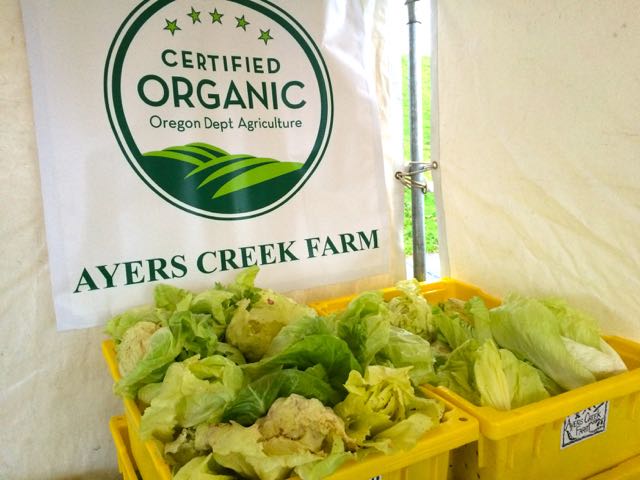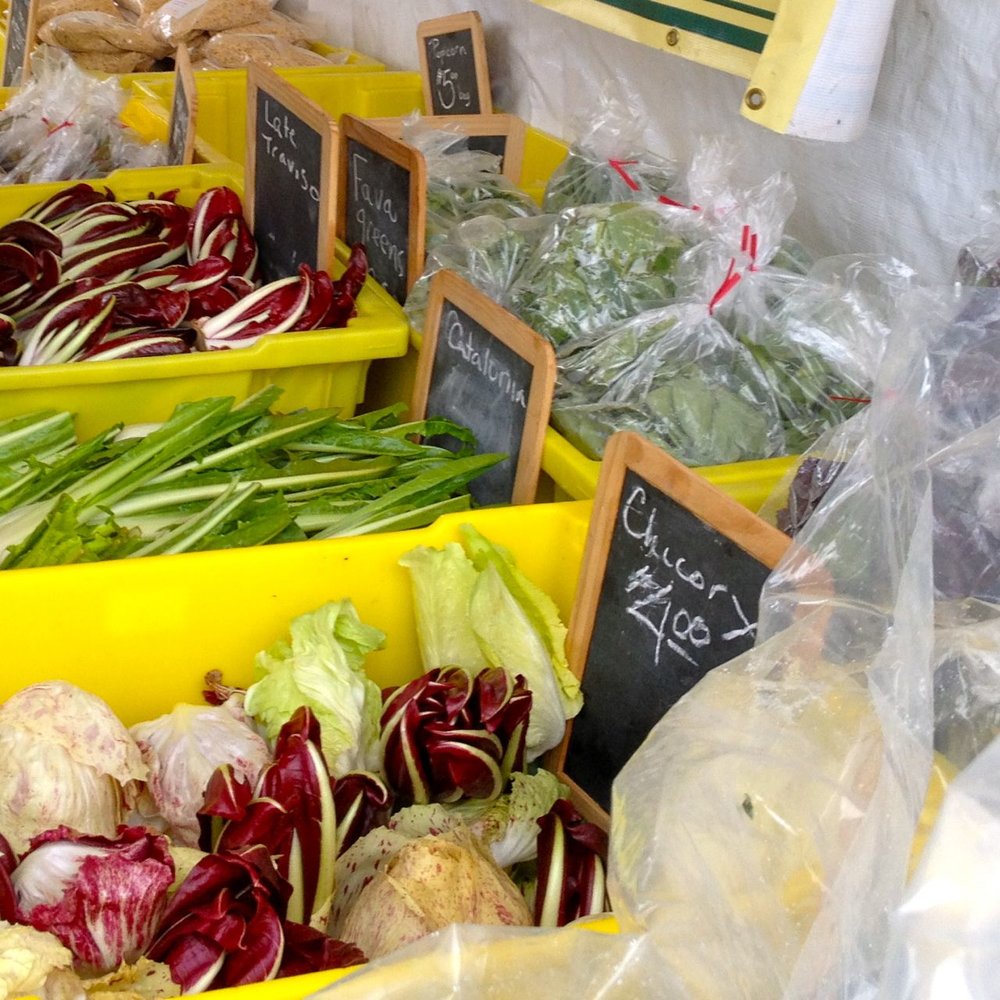Ayers Creek Farm Newsletter January 11 2015 Market
Guest User

When the bell opens the Hillsdale Farmers' Market this Sunday morning at 10:00, it will herald a kinder market. The board has decreed that henceforth, or at least through April when the climate softens, the market shall close at 1:00 PM sharp.
We hope the market will establish 1:00 PM as a permanent closing time, a sentiment that is gathering steam among the dusty-footed vendors, the piepoudres. After 12 years (245 market days to date), both summer and winter, on the pavement at Hillsdale, we know that 70% of our sales consistently take place in the first two hours of the market, and the last hour accounts for less than 5% of our sales. If the day is rainy, cold or hot, the market is dead as a smelt by noon. No wonder, produce quality is best in the first two to three hours, especially in the summer heat, as most of you know. A 1:00 PM closing time year-round is sensible.
The board should consider other changes over the next year. When market moved across the highway to its current location, it grew substantially and went from a summer fling to a year-round relationship. The ease of access to arterial streets and good parking have been critical assets in attracting farmers and customers. Unfortunately, the addition of bike lanes on Vermont Avenue had a negative influence on traffic at the market by eliminating a long stretch of parking spaces. Rather than grousing about the clumsy transportation planning by the city, as easy as that is to do, it is much more productive to rethink how the market uses the site.
Currently, the market stalls occupy more than 70 parking spaces. It is possible to free up these parking spots by creating a space for the vendors on the flat area to the west of the lot – between the lot and the slope leading down to the soccer fields. This would make shopping at the market much easier. There are minor challenges reconfiguring the area, but none insurmountable. The parking lot is unlovely and in need of repair, so it is a good time address improved utilization of the site. Hillsdale is one of the few markets in the region, if any, that is so well poised for improvement.
As the market has developed into a year-round enterprise and is no longer an experiment, safer shelter is warranted as well. A simple 45' by 180' freestanding structure covered in rip-stop polyethylene costs $30,000, with some bells and whistles available for an additional pittance. (Here is a link to an example: Structure ) Simply put, the neighborhood can have a safe and comfortable covered market for roughly the same price as a plain vanilla family car.
Farmers use these durable and utilitarian structures for a wide variety of uses, including as shelters for farmers' markets, so we recognize them as our preferred habitat. Not particularly posh or elegant, true, but they are engineered to survive heavy snow loads and wind. The sunshine passes through while providing shade and shelter for the fruits and vegetables below. As you will note from the link, these structures are manufactured in 14 days, the cover is warrantied for 20 years, and the frame for 50 years. They are assembled in a matter of days as well. From a farmer's perspective it is a very good value. Aside from leveling and preparing the site, there is no foundation or excavation required, a massive cost savings relative to any other cover option. When the market isn't using the shelter, it can be available for school functions or neighborhood events. In other words, it will be a general community asset rather than a dedicated market space.
Hillsdale has an experienced cadre of farmers, some of whom, like us, have been part of the market since it started in 2002. Having adequate parking and a sturdy covering for the market will make it a preferred destination for both farmers and customers for years to come. With some vision and cooperation on the part of the Hillsdale Farmers' Market board and the neighborhood, the rag tag assembly of tents set up on Sundays can evolve into a defining neighborhood fixture. We hope you all encourage Eamon and the board to think creatively about the future of the market. You voice, encouragement and participation is important.
Here is what we are bringing Sunday:
We still have good supplies of preserves, beans, popcorn, cornmeal, cayennes and pumpkin seeds. The onions, sweet potatoes, spuds, horseradish and black radish fill out the bulbs and roots section. We will be slicing Sibley and Musqueé squashes. This week we will have more chicories. At the moment they are the speckled Lusia types. We have had trouble with the quality of the seed, so there is a lot variation in the field, and we are only able to harvest about 10% of what we planted, which is way below the 90% harvested in the past. We are not happy with the state of seed, to put it mildly. In February, we will have longer meditation about the genetics of chicories, and what we are doing to address the problem.
As with Bette Davis and the lyrics of Sondheim, the bitterness in chicories is always a matter of interpretation and taste, some revel in it, others recoil. Varieties and individual plants vary as well. The bitter compounds are in the white latex of the sap and are water soluble, so the problem is easily addressed. Tearing the leaves lengthwise and immediately soaking them in iced water draws out the latex and eliminates almost all of the bitterness. Soaking for 20 minutes or so is generally enough. If you are planning to braise the chicories, quarter them lengthwise and immediately soak in ice water. As with latex paint, if the plant's latex starts to set up and dry, it is no longer water soluble, so have soaking water ready before you tear or cut the heads is important. The ice is critical to the process because the cold shrinks the vascular tissue, forcing the latex out of the leaf. Luke warm or cool water is useless for the task, so don't skimp on the ice.
For a salad, a lemon-based dressing adds a bit sweetness. Cutting vinegar with a bit of orange juice also works. An anchovy fillet squeezed through a garlic press and mixed into the dressing is another fine addition. As a forage crop for livestock, chicories have higher protein content than even legumes such as alfalfa, as well as a hefty dose of minerals. As a result, in recent years seed companies have been offering a greater range of forage chicories, apparently with better seed quality than we see in the varieties grown for human consumption. Regardless, you can't go wrong eating these fine winter greens, right Elsie.
We will see you all Sunday,
The Boutards of Gaston

